Largest Natural Near-Spherical Saltwater Nacreous Pearl in the World
Open FREE Unlimited Store Join Our Newsletter
Lareef A.Samad B.Sc (Hons)
Origin of Name
The title of this webpage refers to an unnamed natural, near-spherical, saltwater, nacreous pearl, the largest ever to appear at a public auction, that featured at at a Woolley & Wallis auction held at its Salisbury Salerooms on May 1st, 2014, and fetched a staggering £811,000 equivalent to US$ 1,368,075. This rare near-spherical saltwater pearl is the largest near-spherical saltwater nacreous pearl in existence, as shall be shown subsequently.

33.147-carat, natural, near-spherical, white, saltwater, nacreous pearl that featured at Woolley & Wallis auction
Characteristics of the unnamed spherical/near spherical pearl
The Shape of the Pearl - Is it spherical or near-spherical ?
The longest and shortest diameter of the pearl are 17.44 mm and 16.51 mm respectively. Using this data we can calculate whether the pearl is spherical or near-spherical. A perfectly spherical or round pearl is defined as a pearl having the same diameter all round or has a variation in diameter of less than 2%, between its shortest and longest diameters. A near-spherical pearl is defined as a pearl having a variation in diameter between 2% and 20%. If the variation in diameter is approximately 20% the pearl is known as a button pearl.
The variation in diameter of a pearl is given by the formula :-
(1 - shortest diameter/longest diameter) x 100 %
Applying this formula we have :-
(1- 16.51/17.44) x 100%
= (1- 0.95) x 100%
= 0.05 x 100
= 5%
Variation in diameter of the pearl = 5%
The variation in diameter lies between 2% and 20%. Hence, by definition the pearl is a near-spherical pearl, even though by appearance it looks like a perfectly round or spherical pearl.
The pearl was accompanied by two lab reports at the Woolley & Wallis auction. The first lab report bearing number 09623 issued by "The Gem and Pearl Laboratory of London," dated 21st January 2014 stated that the pearl measures 16.5-17.4mm, weighs 33.15 cts and is a natural saltwater pearl.
The second lab report bearing number 72642 from SSEF, Switzerland, dated 5th February 2014 stated that the pearl weighs 33.147cts (132.59 grains), measures 16.51 x 17.44mm, and is roundish, half-drilled, the colour of the pearl is white and certifies that the pearl is a natural saltwater pearl.
An appendix letter attached to the same SSEF report states :-
The natural pearl described in Test Report No 72642 from the Swiss Gemmological Institute SSEF possesses extraordinary characteristics and merits a special mention and appreciation.
The described natural pearl exhibits an impressive size and weight of 33.147cts (132.59 grains), combined with an attractive roundish shape and smooth pearl lustre. The pearl shows an attractive white colour with weak rosé and green overtones, poetically also referred to as the "orient of pearls". Such overtones are due to an iridescence effect caused on the surface of pearls and greatly contribute to their beauty.
The combination of well-balanced trace elements found in this pearl is characteristic for a saltwater pearl. A natural pearl of such a large size and quality is very rare and exceptional.
The Gem and Pearl Laboratory of London had not ventured to give an opinion on the shape of the pearl. However, the SSEF report described the pearl as roundish and having an attractive shape. The term "roundish" is a vague term, and may refer to either a spherical or near-spherical pearl. Hence, even SSEF has not committed iteslf in describing the accurate shape of the pearl. However, despite the opinions expressed by the two labs, we now know for certain that the unnamed saltwater nacreous pearl weighing 33.147 carats which appeared at the Wooley & Wallis auction is actually a near-spherical pearl.
The Weight of the Pearl - The Unnamed Pearl is the Largest Near-Spherical Saltwater Nacreous Pearl in the World
The unnamed near-spherical saltwater nacreous pearl due to its extreme rarity, combination of desirable characters and staggering US$ 1,368,075 fetched at the Woolley & Wallis auction, deserve to be included in the List of Famous Nacreous Single Pearls in the world.
The weight of the pearl is 33.147 carats equivalent to 132.59 grains. When included in the List of Famous Nacreous Single Pearls arranged in descending order of weight the 33.147-carat, unnamed near-spherical saltwater nacreous pearl occupies the 23rd position, and hence the pearl becomes the 23rd largest nacreous single pearl in the world. It is also the second largest near-spherical nacreous pearl in the world, and the largest near-spherical saltwater nacreous pearl in the world. The largest near-spherical nacreous pearl in the world is a freshwater pearl weighing 60.36 carats occupying the 14th-position. This pearl appeared at Christie's Dubai Sale in April 2008 and sold for US$ 713,000, the highest ever paid for a natural freshwater pearl.
Table of famous nacreous single pearls arranged in descending order of weight
| S/N | Name of Pearl | Weight in Carats and Grains | Shape of Pearl |
Type of Pearl | Color of Pearl |
| 1 | Danat Sheikha Fathima bint Mubarak Pearl | 856.58 carats, 3426.32 grains | Baroque | Saltwater, nacreous pearl | Convex front-Purplish brownish gray. Concave back- dark gray to black |
| 2 | Pearl of Asia | 600 carats, 2,400 grains | Baroque, garden-egg shaped | Saltwater, nacreous pearl | White |
| 3 | Arco-Valley Pearl | 575 carats, 2300 grains | Baroque | Saltwater, nacreous pearl | White |
| 4 | Big Pink Pearl | 470 carats, 1,880 grains | Baroque | Saltwater, nacreous abalone pearl | Pink |
| 5 | Hope Pearl | 450 carats, 1,800 grains | Baroque drop-shaped | Saltwater, nacreous pearl | White |
| 6 | Christopher Walling Abalone Pearl | 187.5 carats, 750 grains | Horn shaped | Saltwater , nacreous pearl | Multi-colored |
| 7 | Imperial Hong Kong Pearl | 127.5 carats, 510 grains | Irregular drop | Saltwater, nacreous pearl | White |
| 8 | Gogibus Pearl | 126 carats, 504 grains | Pear-shaped drop | Saltwater, nacreous pearl | White |
| 9 | Shah Sofi Pearl | 125 carats. 500 grains | Pear-shaped drop | Saltwater, nacreous perl | White |
| 10 | Survival Pearl | 90.35 carats, 361.40 grains | Baroque | Freshwater, nacreous pearl | White |
| 11 | La Regente | 75.67 carats, 302.68 grains | Pear-shaped drop | Saltwater, nacreous pearl | White |
| 12 | Pearl of Kuwait | 64.35 carats, 257.40 grains | Asymmetrical drop-shape | Saltwater, nacreous pearl | White |
| 13 | Paspaley Pearl | 60.94 carats, 243.76 grains | Perfectly spherical | Saltwater, nacreous, cultured pearl | White |
| 14 | Largest natural freshwater nacreous pearl in the world, that appeared at Christie's sale 7664 at Dubai | 60.36 carats, 241.44 grains | Near-Spherical | Freshwater nacreous pearl | Yellowish- orange to pinkish-orange |
| 15 | Natural Grey/Brown Pearl | 56.81 carats, 227.24 grains | Symmetrical drop-shape | Saltwater, nacreous pearl | Grey/Brown |
| La Peregrina (Original weight) | 55.95 carats, 223.8 grains | Pear-shaped drop | Saltwater, nacreous pearl | White | |
| 16 | Sara/Tavernier/Shaista Khan Pearl | 55.0 carats, 220 grains | Drop-shaped | Saltwater, nacreous pearl | Gray |
| 17 | La Peregrina after drilling and polishing in 1913 | 50.96 carats, 203.84 grains | Pear-shaped drop | Saltwater, nacreous pearl |
White |
| 18 | Peacock Throne Pearl | 50 carats, 200 grains | Pear-shaped drop | Saltwater nacreous pearl | Yellow |
| 19 | Mancini Pearls | 50 carats, 200 grains. 50 carats, 200 grains | Drop-shaped pearls | Saltwater nacreous | White |
20 |
Moghul Pearls | 45.5 carats, 182 grains. 45.5 carats, 182 grains | Pear-shaped drop | Saltwater nacreous pearls | White |
| 21 | Drexel Pearl | 33.80 carats, 135.2 grains | Symmetrical drop-shape | Saltwater nacreous pearl | Black Tahitian |
| 22 | La Pelegrina one | 33.29 carats, 133.16 grains | Pear-shaped drop | Saltwater, nacreous pearl | White |
| 23 | Largest natural near-spherical saltwater nacreous pearl in the world that appeared at Wooley & Wallis auction in London WW | 33.147 carats, 132.59 grains | Near-spherical | Saltwater, nacreous pearl | White |
| 24 | Charles II Pearl | 32.5 carats, 130 grains | Pear-shaped drop | Saltwater, nacreous pearl | White |
| 25 | Tararequi Pearls | 31 carats, 124 grains | Pear-shaped drop | Saltwater, nacreous | White |
| 26 | Bapst Pearls | 113.75 grains, 113.25 grains | Perfectly spherical pearls | Saltwater nacreous pearls | White |
| 27 | La Pelegrina two | 27.88 carats, 111.5 grains | Perfectly spherical pearl | Saltwater nacreous pearl | White |
| 28 | La Reine De Pearls | 27.5 carats, 110 grains | Perfectly spherical pearl | Saltwater, nacreous pearl | White |
| 29 | Oviedo Pearl | 26 carats, 104 grains | Perfectly spherical pearl | Saltwater, nacreous | White |
| 30 | Queen/Patterson Pearl | 23.25 carats, 93 grains | Baroque | Freshwater, nacreous pearl | White |
| 31 | Paspaley Drop-shaped Pearls | 18.75 carats, 75 grains. 18.75 carats, 75 grains | Drop-shaped pearls | Saltwater, nacreous pearl | White |
| 32 | Finest black pearl in Europe in 1900 | 12.25 carats, 49 grains | Pear-shaped drop pearl | Saltwater, nacreous pearl | Black pearl with green overtone |
© internetstones.com
The Color of the Pearl - Hue, Overtone and Orient
The color of a pearl is a combination of its body color and overtones. Commenting on the color of the pearl the Swiss Gemmological Institute SSEF, in an appendix to its report No. 72642 dated February 05, 2014, authenticating the natural saltwater provenance of the pearl, states as follows :-
The pearl shows an attractive white colour with weak rosé and green overtones, poetically also referred to as the "orient of pearls". Such overtones are due to an iridescence effect caused on the surface of pearls and greatly contribute to their beauty.
A pearl's color is the net effect of three traits, known as hue, overtone and orient. Hue is the overall pearl color that one sees on first impression. In otherwords it is the body color. In this case it is white. The white color is due to absence of color-causing pigments associated with conchiolin component of nacre, allowing the white color of aragonite component of nacre to show through.
Overtone, which may or may not be present is the secondary color associated with the main color, such as pink associated with white known as pinkish-white. In this case the overtone colors are rose and green, but weak. Overtone colors appear to float over the surface of the pearl. Overtone is not caused by a pigment, but like Orient is an optical effect produced by refraction of light as it passes through successive layers of aragonite.
The orient or iridescence of a pearl, also not always present, is a colorful rainbow-like sheen caused by the scattering of light by the aragonite platelets in the nacre.
Overtone and Orient (Iridescence) of a pearl are not the same, though the lab report implies they are so. Both Overtone and Orient are optical effects caused by refraction, as light passes through successive layers of aragonite.
The Luster of the Pearl
Luster is the most important of all factors as far as the beauty of a pearl is concerned. Luster is responsible for the so-called inner glow of the pearl, that sets them apart from other gemstones. Luster is a measure of the quality and quantity of light that reflects from the surface and just under the surface of a pearl. It is the reflective quality and brilliance of the surface of the pearl's nacre. The more lustrous a pearl, the more it shines and reflects light and images. When the luster is low the pearl appears white and chalky and has a matte-like appearance. Generally saltwater pearls tend to have a greater luster than freshwater pearls. Luster is dependant on the thickness and translucency of the nacre. In general thicker the nacre the more lustrous is a pearl. A high quality luster results only when the nacre is translucent and the aragonite plates overlap in such a way that the pearl appears lit from within.
The large near-spherical pearl being a saltwater pearl, has a thick and translucent nacre, and accordingly a brilliant luster characteristic of saltwater pearls.
Surface Quality of the Pearl
Pearls being creations of nature always have flaws and blemishes on their surface, to the extent that their presence is a proof of their genuineness. A hundred percent blemish-free pearl does not exist. A pearl that appears blemish-free to the naked eye, may still show some blemishes under a magnifying glass or microscope. GIA classifies surface quality into four categories :- 1) Apparently blemish-free or spotless, or contain minor blemishes not visible to the naked eye. 2) Lightly blemished 3) Moderately blemished 4) Heavily blemished.
The surface quality of this pearl is not given, but close examination of photographs of the pearl shows, that it may fall under category 1 - Apparently blemish-free or spotless or contain minor blemishes not visible to the naked eye.
History of the Unnamed near-Spherical Pearl
The probable oyster species in which the pearl originated
Given the enormous size of the pearl with a shortest and longest diameter of 16.51 mm and 17.44 mm respectively, the oyster that produced the pearl should be equally enormous to accommodate the growing pearl within its tissues. Such an oyster species which can produce such enormous pearls is Pinctada maxima, which can grow to a maximum diameter of 30 cm (12 inches). Pinctada maxima is reputed to be the largest naturally occurring pearl oyster in the world.
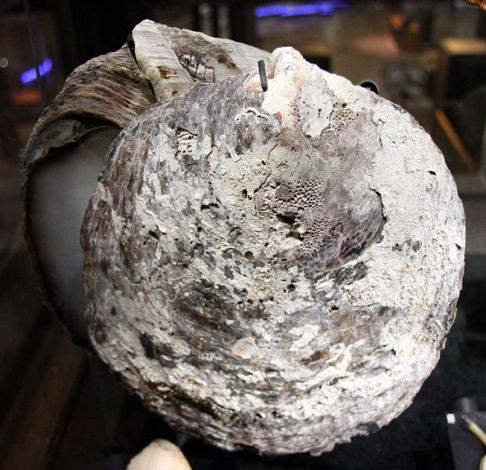
Exterior of Pinctada maxima - Silver-lipped Pearl Oyster
Pinctada maxima commonly known as the South Sea Pearl Oyster, occurs in nature as two possible varieties, the silver-lipped pearl oyster and the golden-lipped pearl oyster, that produces pearls with a range in size from 9 mm to 20 mm. The silvery-white color of the pearl with pink overtones is characteristic of pearls produced by the silver-lipped pearl oyster. Experts believe, that the pearl would have grown inside the silver-lipped pearl oyster for at least ten years to reach such an enormous size.
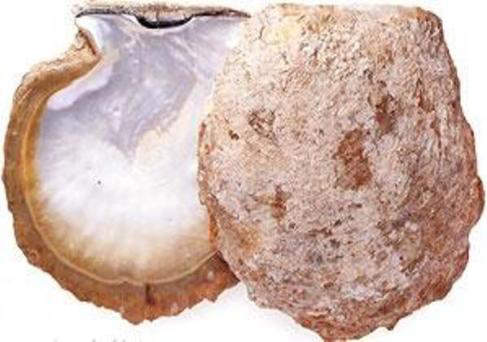
Interior of Pinctada maxima - Silver-lipped Pearl Oyster
Since the pearl has expanded equally on all sides and formed a large near-spherical pearl, in all probability the irritant that was responsible for the formation of the pearl, lodged deep inside the pearl, probably in the gonads, surrounded by soft tissues.
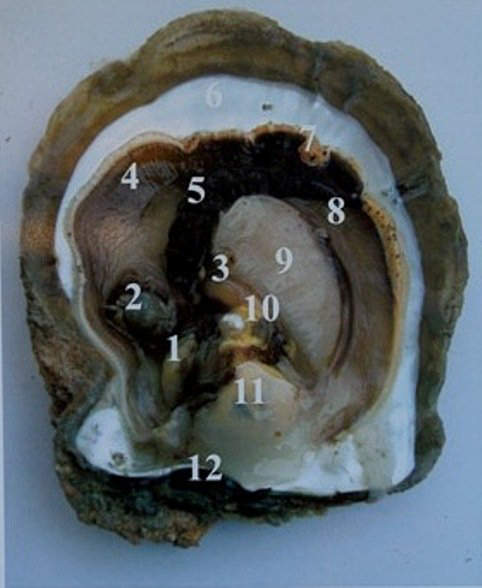
Internal Structure of Pinctada maxima with a spherical pearl sac formed near the gonad - Photo courtsey Willie Creek Pearls
1) Foot 2) Pea Crab 3) Gonad 4) Mantle Tissue 5) Gills
6) Mother of Pearl 7) Sensory Tissue 8) Anus
9)Adductor Muscle 10) Pearl 11) Stomach 12) Hinge
The region where the pearl originated
Undoubtedly, the pearl originated in the South Sea, the natural habitat of the oyster species Pinctada radiata. The South Sea is the sea between the southern coast of China and the northern coast of Australia, that connects the Indian Ocean to the Pacific Ocean. The Indonesian archipelago, Malaysia, Philippines, and Papua New Guinea are situated within this sea.
The environmental conditions of the South Sea, such as its clean waters and the abundant availability of plankton (singled celled floating algae), that constitute the favorite food source of Pinctada maxima, are very conducive to the successful growth and multiplication of the Pinctada maxima pearl oyster, as well as the rapid production of nacre in the formation of the pearl. The warm waters of the sea also speeds up the oyster's metabolism, enhancing the speed of nacre production.
South Sea pearls are characterized by their large size, ranging from 9-20 mm, their unique satin-like luster and their subtle array of colors, such as white, cream, pink, silver and gold. There are two varieties of Pinctada maxima that produce pearls - the silver-lipped and gold lipped oyster, distinguished by the distinct coloration of the outer edge of the mantle.
The possible country where the pearl was found ? The period during which the pearl originated
Pinctada maxima is one of the pearl oysters around which a major cultured pearl industry has developed, in countries with access to the South Sea, such as China, Australia, Indonesia, Myanmar, Philippines and Papua New Guinea. Had this enormous pearl been a cultured pearl, as its matching pearl in the pair of earrings no doubt was as revealed by the X-ray, we can safely predict that the pearl originated after 1965, the year when the technique of culturing South Sea pearls was perfected in Australia, by the pioneering South Sea pearl culturing company Paspaley Pearl Pty. Ltd.
However, since the pearl is a natural South Sea pearl, made entirely of Nacre, its origin is without any doubt pre 1960s. To discover such an extemely rare near-spherical South Sea pearl, hundreds of thousands or perhaps millions of South Sea oysters have to be shucked. Such a scenario was possible if only some form of industry existed that required the manual or mechanical shucking of hundreds of thousands of South Sea pearl oysters. Such an industry did exist in northwestern Australia, the mother-of-pearl industry, the main raw material for the lucrative shell button industry, which began in 1850s at Shark Bay based on the oyster species Pinctada albina and in 1860s at Nickol Bay based on the oyster species Pinctada maxima.
Initially these oyster species were exploited for their silver and golden colored pearls, but subsequently when the international shell button industry were looking for new sources of high-quality mother-of-pearls, Australia became the main supplier of mother-of-pearls to the international market. Pearling activities also gradually shifted from Shark Bay and Nickol Bay, northwards towards Broome, and in 1910 Broome in northwestern Australia became the largest pearling center in the world, producing a major percentage of the world's requirement of mother-of-pearls. The pearling industry in Australia survived until the mid-1950s, with short breaks during the great depression and World War II and finally collapsed with the advent of plastic buttons. It was after the collapse of the mother-of-pearl industry attention was diverted towards the development of a cultured pearl industry based on the South Sea pearl oyster Pinctada maxima.
Based on the above observations, the most probable country where the enormous 33.147-carat near-spherical saltwater nacreous pearl originated is Australia, and the period during which it originated can be anywhere between the 1860s and 1950s. However, the most likely period during which this pearl was discovered was the peak period around 1925 when 400 pearling luggers were engaged in the industry, producing almost 80% of the world's requirement of mother-of pearls.
The story of the re-discovery of the enormous near-spherical natural pearl that hit the auction block at Woolley & Wallis
The story of how such an enormous round natural pearl hit the auction block is as amazing as the staggering price realized by it at the auctions. The pearl was actually part of a matching pair of drop-earrings worn by a Lady, whose husband had given them to her as a gift. Apparently, the Lady had been wearing the drop-earrings occasionally, but had absolutely no idea of the enormous value of one of the pearls she was wearing. Perhaps, the pair of drop earrings were later put aside and was lying somewhere in a locker unattended and forgotten, when such enormous drop-earrings went out of fashion. Then, one fine day when the Lady of the house or her husband was clearing-up the house, the pair of drop-earrings were re-discovered, and the couple decided that it was worhtwhile showing it to a jeweller dealing in antiques, to estimate its value. As luck would have it, someone directed them to Woolley & Wallis auctioneers in Salisbury, Wiltshire, where they met the head of the jewelry department of Wooley & Wallis, Jonathan Edwards.
Edwards was kind enough to examine the two large round pearls that constituted the drop-earrings carefully, and immediately suspected that the two pearls were not identical. He had a hunch that one of the pearls was natural, but was not absolutely sure. Commenting on his find subsequently, Edwards said, "I thought there was a difference between the two because one had an outer layer of about one millimeter thick, but the other seemed to be solid. It is very difficult to tell if a pearl is cultured or natural by looking at it and you can never be 100 percent sure unless you have it X-rayed."
Jonathan Edwards' suspicions were confirmed when the pearls were sent to the Gem and Pearl Laboratory of London and later the Swiss Gemological Institute (SSEF) for testing and authentication. The tests confirmed that while one pearl was a cultured pearl, the other pearl was indeed a rare natural pearl.
The period during which the pair of pearl drop-earrings was designed
The confirmation that one pearl was a natural pearl and the other matching pearl was a cultured pearl, might give an indication as to the approximate period during which the pearl drop-earrings was designed. An enormous cultured South Sea pearl of matching dimensions as the natural near-spherical pearl with diameter 16.51 x 17.44 mm, would have been available for setting only after the technique of culturing South Sea pearls was perfected in the mid-1960s. Hence, the matching pair of drop-earings was most probably designed after the mid-1960s, and belonged undoubtedly to the Mid-Century, a period extending approximately from the 1940s to the 1970s. This was a period when cultured pearls were used increasingly for daytime wear.
Woolley & Wallis Auction House announces the sale of the rare near-spherical natural saltwater pearl at its Salisbury Salerooms on May 1st, 2014
The British Auction House Woolley & Wallis announced the sale of the extremely rare, natural, near-spherical, nacreous, saltwater pearl at its Jewelry Auctions due to be held at its Salisbury Salerooms on May 1st, 2014. The pearl was said to be one of largest natural pearls to appear at a public auction. As stated above, the pearl was accompanied by two lab reports one by the Gem and Pearl Laboratory of London and the other by the Swiss Gemological Institute (SSEF) authenticating the natural saltwater origins of the pearl and specifying the weight, size/dimensions, shape, color,overtones, and luster of the pearl. A moderate pre-sale estimate of £250,000 or US$419,000 was placed on the pearl, but given the staggering performance of such natural pearls at previous public auctions, it was widely speculated that the rare spherical pearl would sell for more than a million US dollars.
The largest near-spherical, nacreous pearl to appear at an auction
The largest near-spherical, nacreous pearl to appear at an auction is the unnamed 60.36-carat (241.44 grains), natural nacreous pearl that appeared at Christie's Contemporary Jewelry & Watches Sale 7664 at Dubai on April 29, 2008, and sold for a whopping US$713,000. However, this pearl was a freshwater pearl and not a saltwater pearl as the pearl appearing at the Wooley & Wallis auctions. This pearl occupies the 14th-position in the above table, and is not only the largest near-spherical, nacreous pearl in the world, but also the largest near-spherical freshwater nacreous pearl in the world.
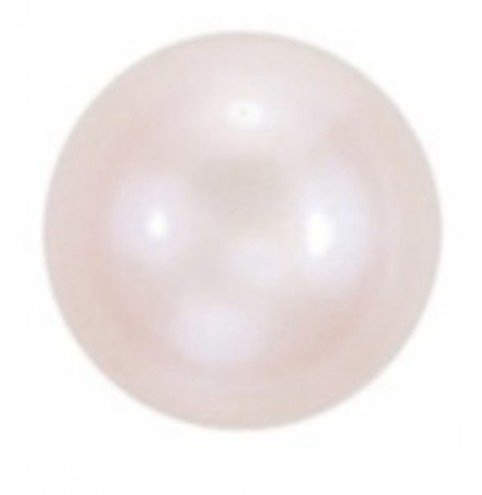 The largest near-spherical, nacreous pearl to appear at an auction
The largest near-spherical, nacreous pearl to appear at an auction
The largest perfectly spherical saltwater nacreous pearl in existence
The largest perfectly spherical, saltwater, nacreous pearl in existence is the 60.94-carat (243.76 grains) Paspaley Pearl . But, this perfectly spherical pearl is a cultured pearl and not a natural pearl.
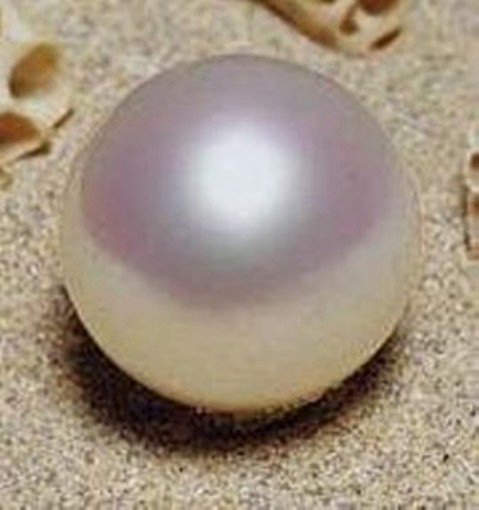
Paspaley Pearl - the largest perfectly spherical saltwater nacreous pearl in existence, but it is a cultured pearl
Other natural spherical saltwater nacreous pearls whose existence were recorded in the "Book of the Pearl"
Other spherical natural salwater pearls whose existence have been recorded and described in 'The Book Of The Pearl' by George Frederick Kunz, first published in 1908, are the 28.44-carat (113.75-grain) and 28.32-carat (113.25 grain) 'Bapst Pearls'; the 27.88-carat (111.52 grains) La Pelegrina-2 pearl; the 27.5-carat (110 grains) La Reine De Pearls and the 26-carat (104 grains) Oviedo Pearls, listed in the above table at positions 26, 27, 28 and 29. However, the present whereabouts of these historic pearls are not known.
Other historic spherical/near-spherical saltwater nacreous pearls whose existence were reported by Jean-Baptiste Tavernier in the Crown Jewels of the great Mughal Emperor Aurangzeb
Other historic spherical/near-spherical saltwater pearls whose existence were reported in the collection of royal jewels belonging to Mughal emperor Aurangzeb - the last of the great Mughal emperors of the Mughal classic period, who ruled from 1658 to 1707-by Jean-Baptiste Tavernier, who was given the rare privilege of examining these jewels on November 10, 1665, are :-
1) A round pearl of great perfection, but a little flat on one side (near-spherical), weighing 49 carats (196 grains) sent as a gift by Shah Abbas II, the King of Persia, to the great Mughal Emperor Aurangzeb.
2) A perfectly spherical white pearl, perfect in every respect, with excellent luster, orient, surface quality and overtones, weighing 32 carats (128 grains). According to Tavernier, this pearl was the only jewel purchased by Emperor Aurangzeb.
3) A spherical pearl of perfect form, whose sketch was indicated as Fig 5, in Tavernier's book, Le Six Voyages de J. B. Tavernier- The Six Voyages of J. B. Tavernier, published in 1676, and whose weight was estimated by G.F.Kunz to be around 110 grains. According to Tavernier, this pearl was the largest perfectly spherical pearl he had ever seen. He further stated that a matching pearl for it was never found, and for that reason it was kept with the unmounted jewels.
The present whereabouts of the above historic pearls mentioned by Jean Baptiste Tavernier are not known.
Two contemporary spherical pearls whose whereab outs are known
Two contemporary spherical pearls whose whereabouts are known are the Abernathy pearl and the Black Beauty pearl. The Abernathy Pearl however, is a white, freshwater nacreous pearl weighing 11 carats (44 grains) and the Black Beauty is a black saltwater nacreous pearl weighing only 6.53 carats (26.12 grains).
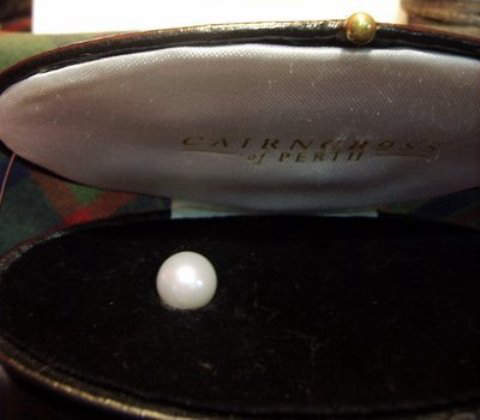
The Abernethy Pearl on display at Cairncross Jewelers, Perth, Scotland - Photo courtesy Kari Pearls
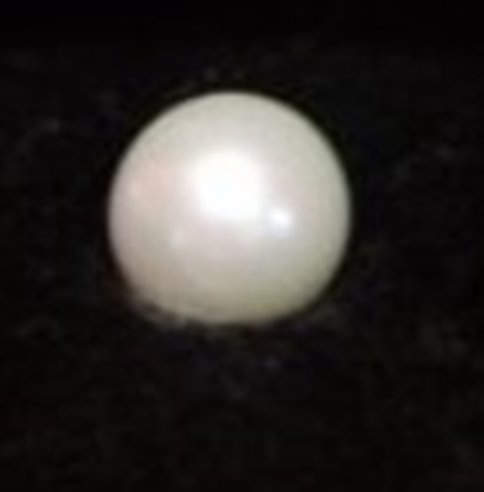
11-carat, perfectly spherical, freshwater, white, nacreous Abernethy pearl - Image enlarged
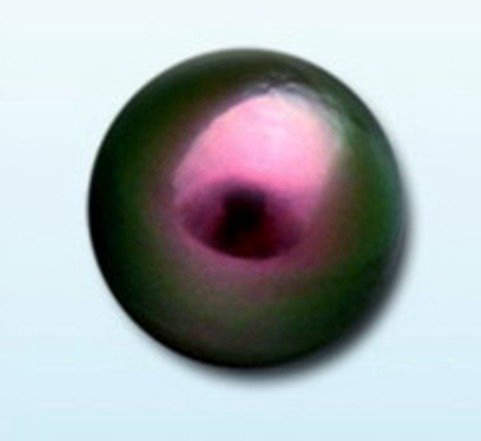
Black Beauty Pearl - 6.53-carat, near-spherical, black saltwater pearl with a rainbow of overtone colors - property of American Pearl Company
Why regular shaped natural pearls fetch staggering prices at public auctions ?
The above statistics clearly bring out the fact about the extreme scarcity of spherical/near-spherical pearls, be it saltwater or freshwater. To find a natural pearl, whatever be its shape, is an extreme rarity. This fact coupled with the observation that most natural pearls are usually baroque/irregular in shape, shows that the occurrence of a regular shaped large pearl such as spherical or near-spherical is an extremely rare event in nature. This explains the staggering prices fetched by such pearls whenever one of them hits the auction block, such as US$713,000 fetched by the 60.36-carat, natural, near-spherical, freshwater pearl that appeared at Christie's sale in Dubai, on April 29, 2008; and the staggering £1.6 million fetched by a matching pair of drop-shaped pearls weighing 34.51 carats and 33.24 carats at a Woolley & Wallis auction on April 26, 2012 and the equally staggering US$ 1,368,075 fetched by the 33.147-carat natural, near-spherical, white, saltwater, nacreous pearl at the Wooley & Wallis auction held on May 1st, 2014.
The successful bidder for the pearl after a competitive phone-bidding was the renowned international jewellers David Morris of London's Bond Street.
As anticipated the auction generated a lot of interest among prospective bidders including phone bidders, and soon after Woolley & Wallis chairman Paul Viney opened the bidding at £30,000 one phone bidder immediately leapt to ten times that figure. The bidding from then onwards was a battle between the phones until the hammer came down at £680,000. However, with buyer's premium and other fees added, the overall price paid for the pearl was £811,600, equivalent to US$ 1,368,075.
The successful bidder for the pearl was the renowned international jewellers David Morris of London's Bond Street. Mr.Phoebe Morris of David Morris jewellers said, 'The pearl is going to be made into a necklace as part of a collection of pearl jewellery we have been putting together for some time. We have a potential buyer for it in Hong Kong.'
You are welcome to discuss this post/related topics with Dr Shihaan and other experts from around the world in our FORUMS (forums.internetstones.com)
Back to Famous Diamonds,Gemstones and Pearls
Related :-
1) Second largest freshwater pearl- yellowish to pinkish orange near spherical nacreous pearl.
External Links :-
Woolley & Wallis, Salisbury Salerooms - May 1st, Jewellery Auction - www.woolleyandwallis.co.uk
References :-
1) Largest Natural Pearl Ever Auctioned Comes Up for Sale - Rob Bates, JCK Magazine, www.jckonline.com
2) Woolley & Wallis, Salisbury Salerooms - May 1st, Jewellery Auction - www.woolleyandwallis.co.uk
3) Extremely Rare Natural Pearl on the Auction Block at Woolley & Wallis - Lareef A. Samad. -news.internetstones.com
4)Rare Natural Pearl Sells for Staggering £811,000 at Woolley & Wallis Auction - Lareef A. Samad. news.internetstones.com
Powered by Ultra Secure
Amazon (USA) Cloud Network

Founder Internet Stones.COM
Register in our Forums
| Featured In
|
|
|
|
|
|
|
|


















